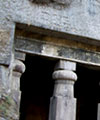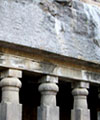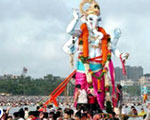| Encyclopedia of Tours and Travel to Maharashtra, featuring information on Fairs & Festivals, Wildlife, Excursion, Adventure and Weather of Maharashtra. |
 |
 |
 |
 |
 |
 |
 |
||
|
Around Aurangabad
[ A Shiva Temple | Ellora Caves | Ajanta | Aurangabad Caves ] A
Shiva Temple Getting there: Close by to Ajanta, Anwa Temple can be reached by taking a well-marked diversion at Golegaon. Private car or taxi is probably the best mode of transport.
Ellora Caves (Distance - 15 km):
The temples at the Ellora Caves are not only known for its significance as a pilgrimage site that throws light on the emergence of tantric art style and religious tolerance exercised in the ancient times, but it is also a world heritage site according to UNESCO for its architectural genius. Built over five centuries by cutting through tones of rock, The Ellora temples are a mix of Buddhist, Hindu and Jain pilgrimage sites that can be toured following from right to left on the basalt Charanadari Hill in Ellora. This mountainside lacks the sheer drop of Ajanta Caves that allow the temples to have courtyards too. Of the 34 rock-cut temples, 12 are Buddhist monasteries (vihars) and prayer halls (chaityas) built under the ruling Chankyas from 600 to 800 AD. The sculptures and paintings, unlike those in the Ajanta caves, correspond to the Vajrayana School of Buddhism where earthy tantric art was the dominant form of expression. The best example of architectural genius is the three-storeyed Buddhist monastery of Tin Tala. The next five centuries saw the emergence of Hinduism and Jainism in the region that is evident from the 17 Hindu temples and the 5 Jain temples built from 600 -1000 AD. The most significant temple (architecturally and religiously) is the world's largest solid temple - Kailash Temple. Devoted to the worship of Shiva, it is the host to the annual Ellora Dance and Music Festival. One of the famous Shiva sculptures is the one where he slays the demon Andhakasura that you cannot miss on your tour to Ellora Caves. The best Jain architectural masterpiece is the two-storeyed Indrasabha temple that you must also visit on your tour to Ellora Caves. Aurangabad is the closest city to Ellora Caves that is well connected with the major cities and towns of Maharashtra and India by air, rail and road.
Ajanta (Distance - 110 km): The artistic skill behind the cave paintings and sculptures of Buddhist religion at the world heritage site of Ajanta Caves in India has inspired generations of artists since its discovery in 1819. These classic caves were discovered by a group of wandering British Officers in much the style of the troops that found the city of Hamumptra in the film Mummy. Contrary to the film, the discovery of these unknown caves on the horseshoe shaped cliff over the Waghoda River, opened unread chapters of Buddhism in India so that you can visit the caves and learn from the lessons inscribed on the walls in cryptic and straight forward imagery and sculptures.There are 30 caves in total of which a few are in an unfinished state. These caves were built in two distinct phases (with distinct Buddhist ideologies) spread apart by 400 years and inhabited from 200 BC to 650 AD. While the five chaityas (praying halls) were where the Buddhist monks prayed the remaining caves functioned as Viharas (monasteries). Caves created in the first phase of construction, which dates back to 2nd and 1st BC, correspond to the Hinayana school of Buddhism where Buddha was represented symbolically as a lotus, a set of footprints etc similar to those found at the Great Stupa, Sanchi. The prominent caves sculptured in accordance to the Hinayana school of Buddhism are the caves numbered 9, 10 (chaityas) and 8, 12,13, 15 (viharas). The second phase of caves were created under the Guptas (from 475 to 500 AD) and correspond to the Mahayana school of Buddhism where the artists didn't shy off from depicting Buddha as a human figure. The prominent caves under Mahayana Buddhist ideology include 1,2,6,17 (viharas) and 19,26 (chaityas). The caves can be easily crossed via the terraced path, a modern construction to facilitate the ease of tourists. The paintings and sculptures are drawn from the life of Buddha, his teachings, the Jatakas, and the daily routine of monks dwelling in the monasteries. Aurangabad is the closest city to Ajanta Caves that is well connected by air, rail and road to the major cities and towns in Maharashtra and India. Tourism of Central India offers specialized tour booking, and travel packages for Ajanta, Maharashtra. Aurangabad Caves: (Distance - 8 km): Aurangabad Caves are artificial caves, dug out of the rather soft rock during the 6th and 7th century. This caves are found on two separate locations, called Western Group Caves (caves 1-5) and Eastern Group Caves (caves 6-10), about 1km from each other. Each group has five caves. Tantric Hinduism influences the architecture and iconography. Cave four of the Western Group Caves is the oldest cave. It is a Hinayana Chaitya with a ridged roof like the Karla Cave near Lonavala. Hinayana (Sanskrit: Lesser Vehicle) is the more orthodox, conservative schools of Buddhism. Chaitya (Sanskrit) is the word for a funeral monument. There is a stupa in front of it, now partially collapsed. The other four Western caves are viharas, which are an early type of Buddhist monastery consisting of an open court surrounded by open cells accessible through an entrance porch. The viharas in India were originally constructed to shelter the monks. 12 finely carved columns support cave 3, the most fascinating cave of the Western Group. They show sculptures portraying scenes from the Jataka tales. Cave 6 belongs to the Eastern Group Caves, and shows very well preserved sculptures of women, which are notable for their exotic hairstyles and ornamentation. There is also a large Buddha figure and an idol of Ganesh located in this cave. Cave 7 is the most interesting of the Aurangabad caves. Most impressive are the sculptures, figures of women, which are scantily clad, and ornately bejeweled. They show the rise of Tantric Buddhism during this period. To the left of Cave 7 is a huge Bodhisattva praying for deliverance from the 8 dangers: fire, the sword of the enemy, chains, shipwreck, lions, snakes, mad elephant and demon (representing death). Accommodation: It is recommended that tourists stay at Aurangabad.
|
||||||||||
|
||||||||||
|
||||||||||
|---|---|---|---|---|---|---|---|---|---|---|